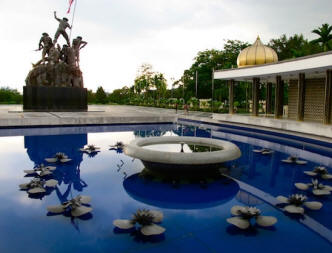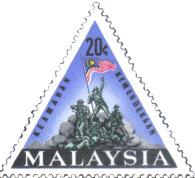National Monument ~ Places to Visit in
Kuala Lumpur
KL Visitors Guide
HOME >
VISITORS
GUIDE >
PLACES TO
VISIT >
KL LAKE GARDENS AREA > NATIONAL
MONUMENT
One of the world's
largest freestanding bronze sculptures, Tugu Negara, or National Monument in
Malay, commemorates a young nations struggle for freedom and to those who
died defending it. Principally it is to the
11,000 people who died during the 12-year communist insurgency known as the
Malayan Emergency (1948-1960).
Located on a hill nearby the Parliament
House, it was officially opened on 8th February 1966 and comprises an area
of 12 acres. The monument complex comprises of the Cenotaph, Central
Pavilion, Self-Reflecting Pool and the Bronze Statue.
 The Cenotaph
The Cenotaph
The Cenotaph stands at the upper entrance of the Tugu Negara, on a 7 stepped
rectangular base. Measuring 15 metres high, this granite monument was built
in 1921 to remember the fallen heroes along with its record of great human
tragedy: First World War (1914-1918), Second World War (1939-1945) and the
Emergency (1948-1960).
You will be able to see words
"To Our Glorious Dead" together. The record from the 2nd World War and the
Malayan Emergency was added later.
.
The Cenotaph was first located near the roundabout on Jalan Sultan
Hishamuddin (formerly called Victoria Avenue) near the old Kuala Lumpur
Railway Station.
When the present site was
chosen, the column was moved there with a permanent base surrounded by a
moat.
 The Central
Pavilion
The Central
Pavilion
The Central Pavilion represents an interesting part of the Tugu Negara. Here
you will find a crescent shaped pavilion with a flat roof topped with 3
golden domes with pointed bronze spires. The floor of the pavilion is made
of marble from the island of Langkawi.
Below the central dome, you can see a vault inside the diamond-shaped black
metal grille enclosure. Here the names of the fallen heroes are recorded on
microfilm, to be kept for posterity.
On the ceiling of the Central
Pavilion, you can see the emblems of the many regiments that served in
Malaya during the 2nd World War and the Malayan Emergency.
The self-reflecting pool measures 90 metres long by 32 metres wide with high
fountains in front of the bronze statue and low fountains behind it. The
water fountain comes on and off automatically every 5 minutes. This is the
best spot to have your photos taken with the bronze monument as your
background.
 The
Bronze Statue
The
Bronze Statue
The monument depicts seven men in which a member of Malayan security forces
is holding the Malaysian national flag (the Jalur Gemilang), aloft.
Constructed in 1966, this
15.54 meter ( 49.21 feet) high bronze statuary commemorates the fallen
heroes who died during the 12-year communist insurgency known as the Malayan
Emergency (1948-1960).
It depicts 7 bronze figures of
soldiers, each of which symbolizes leadership, suffering, unity, vigilance,
strength, courage and sacrifice.
The five figures represents
the victorious allied forces while the other 2 figures that lie on the
ground represents that of the defeated communist forces.
The idea of erecting the bronze monument came to the late Tunku Abdul Rahman
Putra Al Haj, Malaysia's first prime minister, in 1960 when he visited the
USMC war memorial in Arlington.
The monument was designed by
Felix de Weldon who also designed the famous USMC memorial in Arlington,
Virginia, United States. The late Tunku managed to meet up with Felix and
persuaded him to design one for Malaysia too. The sculpture was casted in a
foundry in Rome at a cost of RM600, 000.
The granite base of the monument bears only inscriptions in English with
Roman script and Malay and also in Arabic script: "Dedicated to the
heroic fighters in the cause of peace and freedom, May the blessing of Allah
be upon them"

It went through an extensive renovation in 1975 after it was damaged in an
explosion set off by suspected communist terrorists. On July 31 every year,
when the country celebrates Warriors Day, the Tugu would be the focus as the
King, the Prime Minister and heads of military and police lay wreaths in
remembrance of the fallen heroes.
Over the years, the place has somewhat lost its glory. The Flag, Jalur
Gemilang, is now raised at dusk and lowered at dawn, without elaborate
ceremony, by a soldier.
This contrasts with the scene
about a decade ago when there would be a ceremony conducted by a squad of
soldiers, officers and men in Number One Dress (ceremonial uniform)
steeped in military tradition. The raising and lowering of the flag was
accompanied by the Last Post on the bugle blown by a soldier.
Best Way to Visit - Take KL
City Tour
A private tour that allows you to see the major landmarks of the city and its suburbs.
 PLACES & SIGHTSEEING ~ LAKE GARDENS AREA
PLACES & SIGHTSEEING ~ LAKE GARDENS AREA
PARLIAMENT HOUSE
NATIONAL MONUMENT
BUTTERFLY PARK
ORCHID & HIBISCUS GARDENS
KL BIRD PARK
ISLAMIC ARTS
MUSEUM NATIONAL
MOSQUE
OLD RAILWAY
STATION
NATIONAL
MUSEUM


 The Cenotaph
The Cenotaph The Central
Pavilion
The Central
Pavilion The
Bronze Statue
The
Bronze Statue